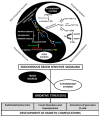Oxidative stress as an underlying contributor in the development of chronic complications in diabetes mellitus
- PMID: 23385234
- PMCID: PMC3588043
- DOI: 10.3390/ijms14023265
Oxidative stress as an underlying contributor in the development of chronic complications in diabetes mellitus
Abstract
The high prevalence of diabetes mellitus and its increasing incidence worldwide, coupled with several complications observed in its carriers, have become a public health issue of great relevance. Chronic hyperglycemia is the main feature of such a disease, being considered the responsible for the establishment of micro and macrovascular complications observed in diabetes. Several efforts have been directed in order to better comprehend the pathophysiological mechanisms involved in the course of this endocrine disease. Recently, numerous authors have suggested that excess generation of highly reactive oxygen and nitrogen species is a key component in the development of complications invoked by hyperglycemia. Overproduction and/or insufficient removal of these reactive species result in vascular dysfunction, damage to cellular proteins, membrane lipids and nucleic acids, leading different research groups to search for biomarkers which would be capable of a proper and accurate measurement of the oxidative stress (OS) in diabetic patients, especially in the presence of chronic complications. In the face of this scenario, the present review briefly addresses the role of hyperglycemia in OS, considering basic mechanisms and their effects in diabetes mellitus, describes some of the more commonly used biomarkers of oxidative/nitrosative damage and includes selected examples of studies which evaluated OS biomarkers in patients with diabetes, pointing to the relevance of such biological components in general oxidative stress status of diabetes mellitus carriers.
Figures


Similar articles
-
Diabetes and the impairment of reproductive function: possible role of mitochondria and reactive oxygen species.Curr Diabetes Rev. 2008 Feb;4(1):46-54. doi: 10.2174/157339908783502398. Curr Diabetes Rev. 2008. PMID: 18220695 Review.
-
Oxidative stress and the use of antioxidants in diabetes: linking basic science to clinical practice.Cardiovasc Diabetol. 2005 Apr 29;4:5. doi: 10.1186/1475-2840-4-5. Cardiovasc Diabetol. 2005. PMID: 15862133 Free PMC article. Review.
-
Hyperglycemia-induced oxidative stress and its role in diabetes mellitus related cardiovascular diseases.Curr Pharm Des. 2013;19(32):5695-703. doi: 10.2174/1381612811319320005. Curr Pharm Des. 2013. PMID: 23448484 Review.
-
AGEs, rather than hyperglycemia, are responsible for microvascular complications in diabetes: a "glycoxidation-centric" point of view.Nutr Metab Cardiovasc Dis. 2013 Oct;23(10):913-9. doi: 10.1016/j.numecd.2013.04.004. Epub 2013 Jun 17. Nutr Metab Cardiovasc Dis. 2013. PMID: 23786818 Review.
-
Association of Glycemic Indices (Hyperglycemia, Glucose Variability, and Hypoglycemia) with Oxidative Stress and Diabetic Complications.J Diabetes Res. 2020 Oct 12;2020:7489795. doi: 10.1155/2020/7489795. eCollection 2020. J Diabetes Res. 2020. PMID: 33123598 Free PMC article. Review.
Cited by
-
Increased self-care activities and glycemic control rate in relation to health education via Wechat among diabetes patients: A randomized clinical trial.Medicine (Baltimore). 2018 Dec;97(50):e13632. doi: 10.1097/MD.0000000000013632. Medicine (Baltimore). 2018. PMID: 30558051 Free PMC article. Clinical Trial.
-
Pioglitazone Inhibits the Expressions of p22(phox) and p47(phox) in Rat Mesangial Cells In Vitro.ISRN Endocrinol. 2014 Feb 3;2014:601352. doi: 10.1155/2014/601352. eCollection 2014. ISRN Endocrinol. 2014. PMID: 24639901 Free PMC article.
-
Diabetic Polyneuropathy in Type 2 Diabetes Mellitus: Inflammation, Oxidative Stress, and Mitochondrial Function.J Diabetes Res. 2016;2016:3425617. doi: 10.1155/2016/3425617. Epub 2016 Dec 12. J Diabetes Res. 2016. PMID: 28058263 Free PMC article. Review.
-
Markers of Oxidative Stress during Diabetes Mellitus.J Biomark. 2013;2013:378790. doi: 10.1155/2013/378790. Epub 2013 Dec 17. J Biomark. 2013. PMID: 26317014 Free PMC article. Review.
-
Effects of the cyclophilin-type peptidylprolyl cis-trans isomerase from Pyropia yezoensis against hydrogen peroxide-induced oxidative stress in HepG2 cells.Mol Med Rep. 2017 Jun;15(6):4132-4138. doi: 10.3892/mmr.2017.6517. Epub 2017 Apr 27. Mol Med Rep. 2017. PMID: 28487964 Free PMC article.
References
-
- World Health Organization. [accessed on 10 February 2012]. Available online: http://www.who.int/diabetes/en.
-
- International Diabetes Federation. [accessed on 12 April 2012]. Available online: http://www.diabetesatlas.org.
-
- Sociedade Brasileira de Diabetes. Diretrizes da Sociedade Brasileira de Diabetes [in Portuguese] Sociedade Brasileira de Diabetes; Rio de Janeiro, Brazil: 2006.
-
- Fowler M.J. Microvascular and macrovascular complications of diabetes. Clin. Diabetes. 2008;26:77–82.
-
- Haffner S.M., Lehto S., Rönnemaa T., Pyörälä K., Laakso M. Mortality from coronary heart disease in subjects with type 2diabetes and in nondiabetic subjects with and without priormyocardial infarction. N. Engl. J. Med. 1998;339:229–234. - PubMed
LinkOut - more resources
Full Text Sources
Other Literature Sources

